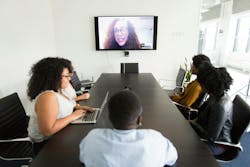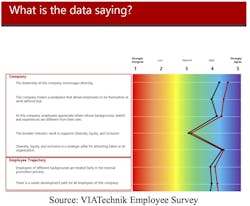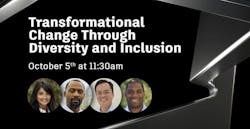Getting diversity, equity, and inclusion going in AEC firms
As the awareness of Diversity, Equity, and Inclusion continues to grow, the conversation must evolve from simply why this needs to be done to also include ‘how’ this should be done. Today we see leading general contractors making strides into improving diversity in their leadership ranks.
Yet, when VIATechnik surveyed 150 high schoolers in Chicago, where diversity is a feature of everyday life, we are finding that very few people want to enter the industry. Just 1% of surveyed high schoolers were interested in construction, and responses often included statements such as “sounds fun, but not for me”, and “seems like a lot of hard labor.” How can the industry be successful at DE&I if we aren’t attracting the next generation talent pool into our space?
Our DE&I effectiveness has been on a gradual upward trend, but the gains have come too slowly; accelerating that trend may be the most powerful approach we have for addressing the ongoing overall labor shortage in the industry. As a professional services organization built on attracting the best and brightest talent, VIATechnik relies on finding new ways to do just that. Here are some tips that we’ve learned through our DE& I journey.
Tips to Make Diversity, Equity, and Inclusion Happen
Start with a framework. It’s important for each firm in construction or related industries to establish a framework for building diversity. It can’t just be about meeting the numbers. It starts with finding the right people with the right talent and sourcing them from diverse personal and professional backgrounds. We must also provide meaningful professional development opportunities that put them in a position to impact the organization and the industry as a whole.
At VIATechnik, we think of ourselves as holding an ongoing “house party,” and we continuously ask ourselves how to make ours the party the one people want to attend. Create an environment that diverse candidates want to go to because they feel included when they get there. If your just recruit, that will fail and people will leave.
Inclusion for us is making sure our people feel like they’re playing for the home team, like Michael Jordan playing at the United Center. We see organizations bring in the right talent with the right diversity, but some are set up to make their team feel like Michael Jordan playing at Madison Square Garden. We want our team members to succeed and create a virtuous cycle.
Collect Data and Act on the Findings. How well is the organization doing? How do we make data driven decisions? At VIATechnik we issued a survey to understand how well we were doing around DE&I. The survey exposed some areas to work on and provided an opportunity for measurable improvement. After all, the first step toward improvement is to identify where you need to go.
Find Mentors and Advisors. Reach out to people you see making strides in their own organization. I have a lot of respect for Cliff Cole from the Penta Group, and he’s given me valuable advice through various conferences and collaborative discussions. There are many, many qualified people in various organizations leading successful efforts at DE&I. They have gone through a similar journey and can serve as guides on your own journey of continuous improvement.
Crowd Source Ideas. At first we had relied on data, but the data only showed that we were doing well, not what to focus on in order to improve. And so we followed the advice I received: talk to our team members. The input we received was invaluable, and it often distilled down to the simple mantra of establishing the human element, helping managers know how to show that they cared about the person and not just the work. The ways to do that were wide-ranging: simple things like asking how things were going back home or learning about someone’s food; forming book clubs that focused on cultural backgrounds; and movie nights featuring films including historical figures or other relevant individuals.
The tips I share here are simple, and things that every organization can do without a lot of resources. Time will tell if we make a measurable impact, but this is something we will continue to measure and improve on, just like any aspect of our business.
We encourage those interested in learning more to attend our virtual panel on October 5 at Autodesk University. Industry leaders Cliff Cole, Anton Dy Buncio, Bruce Orr, and Neetha Puthran will expand on the ways in which DE&I is important and provide tips on how to build a successful talent program. Let’s transform our industry into DE&I leaders – not only to do what’s right, but also show others how to successfully build Diversity, Equity, and Inclusion programs.


